|
[December 18th 2002]

Electrohype 2002
At the beginning of October 2002, the
first Nordic biennial for computer-based art was held in Malmoe,
and, naturally, we were on the spot. Here is a selection of the
works. Enjoy! Text and photo: Kristine Ploug. Translated
by Nina Jagd Andersen
Electrohype 2002
23. - 27. October
Carolinahallen
Östergatan 7, Malmoe
and
Malmö Konsthall
St. Johannesgatan 7, Malmö
www.electrohype.org
Contributing artists: Laura Beloff / Erich
Berger (Finland / Austria), Andrew C. Bulhak (Australia), Rikard
Lundstedt (Sweden), Ellen Røed (Norway), Oncotype / Subsilo
/ Dinsen / Christiansen (Denmark), C. Anders Wallén (Sweden),
John F. Simon, Jr. (USA), Marek Walczak / Martin Wattenberg (USA),
Magnus Wassborg (Sweden), Thomas Broomé (Sweden), Helen Evans
/ Heiko Hansen (France), Lisa Jevbratt (Sweden), Federico Muelas
(Spain), Paul Smith / Vicky Isley (UK), Gisle Frøysland (Norway),
Victor Vina (UK)
Thomas Broomé
HellHunt by Thomas Brommé was one of the
truly entertaining works at Electrohype 2002. HellHunt is a paranoid
program placed on a computer that searches the internet for diabolism
in the form of the symbol of the devil, the pentagram. HellHunt
finds images on the internet and looks for angles which - if a line
is drawn between them - make up a pentagram. When HellHunt has found
something, it saves the destination and sends them a friendly e-mail
with an urgent request to dispose of the devilry. And often, HellHunt's
pinpointing of diabolism is very surprising - while we were there,
a pentagram was found in an angle between the Eiffel tower and some
trees!
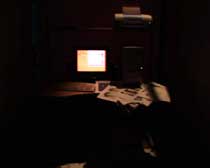 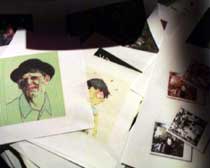
Thomas Broomé
(Smart Studio, Sweden): HellHunt
Lisa Jevbratt
The work by Swedish Lisa Jevbratt, Out of the Ordinary,
was an interface to the controversial surveillance software Carnivore,
created by Radical Software Group, a software group under the internet
portal Rhizome, and it can
be downloaded for free. But even though Carnivore and Jevbratt's
interfaces make for a fascinating and frightening project, it never
becomes as interesting to watch it in an exhibition as it must be
to monitor your local network! See more of Lisa Jevbratt at www.jevbratt.com
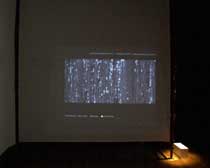
Lisa Jevbratt (Sweden):
Out of the Ordinary
John F. Simon, Jr.
For Electrohype 2002, American Simon contributed two works
that were both based on the same concept, little flat screens with
graphic patterns in movement. One of the works, Every Icon,
is divided into a multitude of black and white squares, and at first
glance it is quite boring, but actually the software behind it is
trying out all existing combinations of the black and white squares.
According to Simon's calculations, there are 4,3 billion combinations,
and it would take the work sixteen months to go through all of them.
The work runs completely mechanically, but to the viewer, occasionally
recognisable icons and patterns turn up, and to Simon, that is the
what is fascinating: that programming can actually create something
that is recognisable to humans.
See more of John F. Simon, Jr. at www.numeral.com
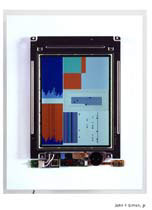
John F. Simon, Jr. (USA)
: Every Icon og Color Panel v1.0
Laura Beloff / Erich Berger
Spinne is German for spider. In addition, the work is based
on the web metaphor: web understood as the World Wide Web of the
internet and as cobweb. The work consists of four large, physical,
constructed spiders and four web spiders that search the internet
for pre-defined words. When the web spiders find something, they
react by making a sound. Read more about the work at www.saunalahti.fi
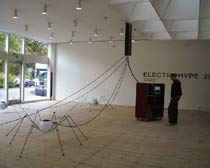 
Laura Beloff and Erich Berger (Austria):
Spinne
Andrew C. Bulhak
The postmodernism machine generates large amounts of
text that is complete nonsense. Anyone who has frequented the institutions
of higher education will recognise something, and it is quite a
lot of fun. You can also try it online www.elsewhere.org
 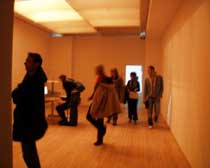
Andrew C. Bulhak (Austria):
The Postmodernism Generator
Ellen Røed
At the basis, the work consists of nothing. An empty,
white room. But when anyone enters the room, they are filmed and
projected onto the wall. At the same time, all sound is recorded,
and, having passed through a computer, it is transformed into different
letters, whose colour and size depend on the sound.
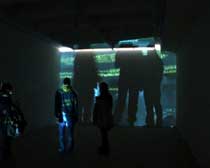
Ellen Røed (Norway):
Feedback
Oncotype / Subsilo / Dinsen / Christiansen
The Danish element of the exhibition consisted of a large
screen and a microphone. Loads of statistic information about the
Danes runs across the screen, but when anybody speaks into the microphone,
the statistics are interrupted by a person who tells a very personal
story.

Oncotype / Subsilo / Dinsen / Christiansen
(Denmark): Rekyl
Marek Walczak / Martin Wattenberg
The work is a large screen, placed horizontally as a
table, and a computer keyboard. When something is typed on the keyboard,
it shows up on the screen as ordinary text and at the same time
generates rooms in the apartment. Notice the text…
Try for yourself online at turbulence.org
 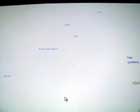 
Marek Walczak og Martin
Wattenberg (USA): Apartment
Magnus Wassborg
The two intelligent - according to Wassborg - figures
are hacked into behaving psychotically…
Try it live at www.inthecomputer.org

Magnus Wassborg (Sweden):
FulHack
Rikard Lundstedt
You were given a set of headphones, and by manipulating
a joystick you could navigate through a minimalistic virtual landscape
consisting of luminous lines against a black background. At the
same time, the movements of the joystick created a series of sounds,
and in all its simplicity it was a rather fascinating experience.

Rikard Lundstedt (Sweden):
Sound Room
C. Anders Wallén
jour et nuit had a curious effect on the experience
of the exhibition. It consisted of a computer projection on the
back wall of one of the white booths that divided the exhibition
in Carolinahallen, as well as a number of sensors. On first looking
into the booth, you would see a man standing, but when you stepped
into the booth, the man left and did not return until you stepped
out again. It was a really odd social experience to have the work
of art flee from you!
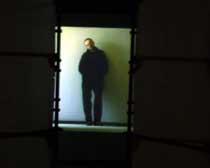
C. Anders Wallén
(Sweden): jour et nuit
|